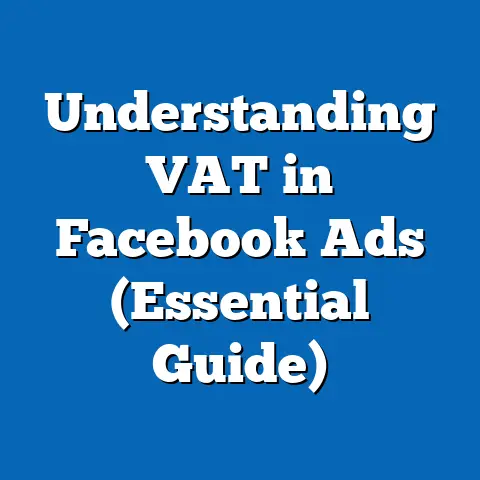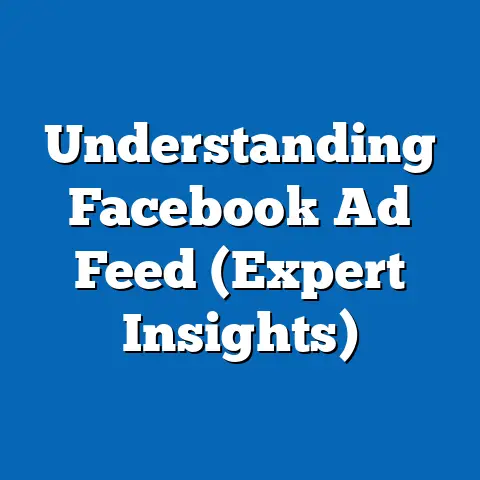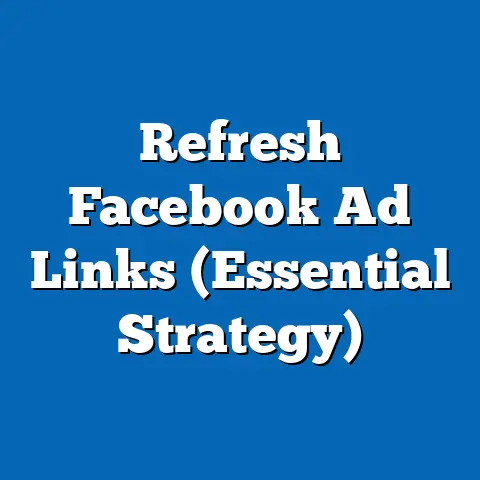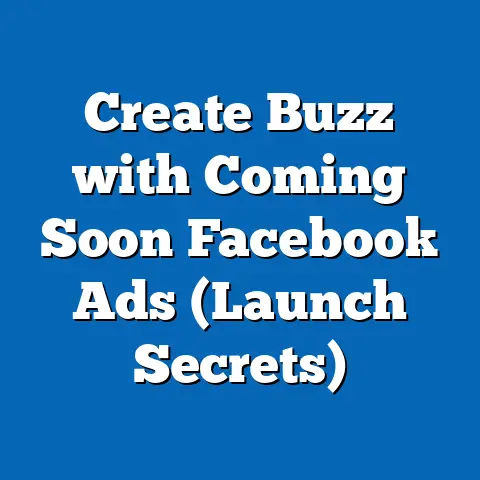Facebook Ads vs. Google Ads: (Key Insights Revealed)
Digital advertising has become the lifeblood of modern business. I’ve seen firsthand how even the smallest startups can achieve incredible growth by strategically placing their message in front of the right eyes. Think about it: traditional advertising like billboards and newspaper ads were a shot in the dark, hoping to hit someone who might be interested. Now, we can laser-target our ideal customer with an ad tailored specifically to their interests.
Platforms like Facebook and Google have democratized advertising, making it accessible to businesses of all sizes. I remember when I first started experimenting with online ads; the possibilities seemed endless. But with so many options, it’s easy to get overwhelmed. That’s why understanding the nuances of each platform is crucial.
It’s not just about throwing money at ads and hoping for the best. It’s about understanding who you’re trying to reach, what message will resonate with them, and where they’re most likely to see your ad. This is where the real magic happens, where you can forge an emotional connection with potential customers.
In this article, I’m going to break down the key differences between Facebook Ads and Google Ads. We’ll explore their strengths, weaknesses, and how to choose the right platform (or combination of platforms) for your specific business needs. Get ready to dive in and unlock the power of targeted digital advertising!
Overview of Facebook Ads
Facebook Ads is a powerhouse for businesses looking to connect with their target audience on a personal level. It leverages the vast amount of data Facebook (now Meta) collects on its users to deliver highly targeted ads. Think of it as having a conversation with someone who’s already interested in what you have to offer.
So, how do Facebook Ads work? It’s a multifaceted system, but let’s break it down.
First, you need a Facebook Business Manager account. This is your central hub for managing your ads, Pages, and other business assets. Once you’re set up, you can create ad campaigns with specific objectives, such as driving website traffic, generating leads, or increasing brand awareness.
Next comes the fun part: choosing your ad format and placement. Facebook offers a variety of ad formats, including:
- Image Ads: These are simple, visually appealing ads that feature a single image and some text.
- Video Ads: Video is king on social media, and Facebook video ads can be incredibly engaging.
- Carousel Ads: Showcase multiple products or features in a single ad with swipeable cards.
- Collection Ads: These are designed for e-commerce businesses and allow users to browse and purchase products directly from the ad.
- Instant Experience Ads: These are full-screen, mobile-optimized experiences that load instantly when a user clicks on an ad.
As for placement options, you can choose where your ads appear on Facebook and Instagram, including:
- News Feed: The primary feed where users see updates from friends, family, and Pages they follow.
- Stories: Short-form video and image content that disappears after 24 hours.
- Marketplace: A platform for buying and selling goods locally.
- Right Column: Ads that appear on the right side of the Facebook desktop site.
- Audience Network: A network of third-party apps and websites where Facebook ads can be displayed.
But the true power of Facebook Ads lies in its targeting capabilities. You can target users based on a wide range of factors, including:
- Demographics: Age, gender, location, education, job title, etc.
- Interests: Hobbies, passions, and topics they’ve shown interest in on Facebook.
- Behaviors: Purchase history, online activity, and device usage.
- Custom Audiences: Upload your own customer data (email lists, phone numbers) to target existing customers or create lookalike audiences.
- Lookalike Audiences: Find new customers who are similar to your existing customers.
I’ve had great success with lookalike audiences. I once ran a campaign for a local bakery, targeting people who were similar to their existing customers. The results were amazing – we saw a significant increase in website traffic and in-store sales.
Creative storytelling is also crucial for Facebook Ads. People are scrolling through their feeds to connect with friends and family, so your ad needs to stand out and grab their attention. Use high-quality visuals, compelling copy, and a clear call to action. Don’t be afraid to evoke emotions – tell a story that resonates with your target audience.
Example:
I remember a campaign I ran for a non-profit organization that helped rescue animals. We created a video ad featuring heartwarming stories of rescued animals finding loving homes. The ad was incredibly successful because it tapped into people’s emotions and inspired them to donate.
Key Takeaway: Facebook Ads is a powerful platform for reaching a highly targeted audience with engaging and creative content. By understanding the different ad formats, placement options, and targeting capabilities, you can create campaigns that drive real results.
Overview of Google Ads
Google Ads, on the other hand, is all about capturing intent. When people search for something on Google, they’re actively looking for information, products, or services. Google Ads allows you to place your ad in front of those users at the exact moment they’re searching for what you offer. It’s like being in the right place at the right time.
Google Ads operates primarily through search ads, display ads, and YouTube ads. Let’s take a closer look at each:
- Search Ads: These are text-based ads that appear at the top and bottom of Google search results pages. They’re triggered by specific keywords that users search for.
- Display Ads: These are visually appealing ads that appear on websites across the Google Display Network (GDN). The GDN includes millions of websites, blogs, and apps, allowing you to reach a broad audience.
- YouTube Ads: These are video ads that appear before, during, or after YouTube videos. YouTube is the second largest search engine in the world, making it a powerful platform for reaching a large audience.
The targeting mechanisms in Google Ads are different from those in Facebook Ads. While Facebook Ads focuses on demographics, interests, and behaviors, Google Ads focuses on:
- Keyword Targeting: Target users based on the keywords they search for on Google.
- Contextual Targeting: Target websites and apps that are relevant to your products or services.
- Remarketing: Target users who have previously visited your website or interacted with your ads.
- Demographic Targeting: Similar to Facebook, you can target users based on age, gender, location, and other demographic factors.
The intent-driven nature of Google Ads is a key advantage. You’re reaching users who are actively looking for what you offer, which means they’re more likely to convert into customers. This is especially valuable for businesses that sell products or services with a clear purchase intent.
Example:
I worked with a plumbing company that was struggling to get new customers. We ran a Google Ads campaign targeting keywords like “plumber near me” and “emergency plumbing services.” The campaign was incredibly successful because we were reaching people who needed a plumber right now.
Key Takeaway: Google Ads is a powerful platform for capturing intent and reaching users who are actively searching for what you offer. By understanding the different ad types and targeting mechanisms, you can create campaigns that drive leads and sales.
Key Differences Between Facebook Ads and Google Ads
Now that we’ve covered the basics of Facebook Ads and Google Ads, let’s dive into the key differences between the two platforms. Understanding these differences is crucial for choosing the right platform (or combination of platforms) for your business.
- User Intent: This is arguably the biggest difference between the two platforms. Google Ads targets users with high purchase intent. They’re actively searching for something, which means they’re further down the buying funnel. Facebook Ads, on the other hand, is more about brand discovery and engagement. Users are scrolling through their feeds to connect with friends and family, so your ad needs to grab their attention and pique their interest.
- Ad Formats and Creativity: Facebook Ads offers a wide range of visually appealing ad formats, including images, videos, carousels, and instant experiences. The focus is on creating engaging content that captures users’ attention and tells a story. Google Ads, especially search ads, are more text-based. While display ads and YouTube ads offer more creative opportunities, the primary focus is on delivering a clear and concise message that answers the user’s query.
- Cost Structure: Both platforms offer a variety of pricing models, including cost-per-click (CPC), cost-per-impression (CPM), and cost-per-acquisition (CPA). However, the factors that influence ad costs can differ. On Google Ads, keyword competition plays a major role. Highly competitive keywords will typically have higher CPCs. On Facebook Ads, targeting and audience size can influence costs. Highly specific targeting can lead to higher CPMs.
- Analytics and Performance Tracking: Both platforms provide robust analytics and performance tracking tools. However, the types of data they track can differ. Google Ads focuses on tracking keyword performance, click-through rates, and conversion rates. Facebook Ads focuses on tracking engagement metrics like likes, comments, shares, and video views. Both platforms offer valuable insights into user behavior, but they provide different perspectives.
I’ve found that Google Ads is great for generating immediate leads and sales, while Facebook Ads is better for building brand awareness and nurturing relationships with potential customers.
Example:
I worked with an e-commerce business that sold handcrafted jewelry. We ran Google Ads campaigns targeting keywords like “handmade earrings” and “unique necklaces.” We also ran Facebook Ads campaigns showcasing the craftsmanship and artistry of the jewelry. The Google Ads campaigns drove immediate sales, while the Facebook Ads campaigns helped build brand awareness and attract new customers.
Key Takeaway: Understanding the key differences between Facebook Ads and Google Ads is crucial for choosing the right platform (or combination of platforms) for your business. Consider your target audience, marketing goals, and budget when making your decision.
Pros and Cons of Facebook Ads
Let’s weigh the advantages and disadvantages of using Facebook Ads.
Pros:
- Extensive Targeting Options: Facebook’s detailed targeting capabilities are unmatched. You can reach users based on demographics, interests, behaviors, and even custom audiences. This allows you to create highly targeted campaigns that resonate with your ideal customer.
- High Engagement Rates: Facebook is a social platform, which means users are already engaged and interacting with content. This makes it easier to capture their attention and drive engagement with your ads.
- Visually Appealing Content: Facebook Ads allows you to create visually appealing content that tells a story and captures users’ emotions. This is especially important on a platform where users are constantly bombarded with information.
- Brand Building: Facebook Ads is great for building brand awareness and nurturing relationships with potential customers. You can use ads to share your brand story, showcase your products or services, and engage with your audience.
- Relatively Low Cost: Compared to other advertising platforms, Facebook Ads can be relatively low cost, especially if you’re targeting a niche audience.
Cons:
- Ad Fatigue: Users can get tired of seeing the same ads over and over again, which can lead to ad fatigue. It’s important to refresh your ads regularly and experiment with different creative approaches.
- Competition for Attention: Facebook is a crowded platform, which means you’re competing for attention with countless other businesses and individuals. Your ad needs to stand out and grab users’ attention in a matter of seconds.
- Algorithm Changes: Facebook’s algorithm is constantly changing, which can impact the performance of your ads. It’s important to stay up-to-date on the latest algorithm changes and adjust your strategies accordingly.
- Lower Purchase Intent: Compared to Google Ads, Facebook Ads typically targets users with lower purchase intent. This means you may need to work harder to convince them to make a purchase.
- Privacy Concerns: In recent years, Facebook has faced increased scrutiny over its data privacy practices. This has led to some users becoming more wary of targeted advertising.
Example:
I once ran a Facebook Ads campaign for a local restaurant. We targeted users who were interested in food, dining, and local restaurants. The campaign was initially successful, but we started to see ad fatigue after a few weeks. To combat this, we refreshed our ads with new images and copy. We also experimented with different targeting options.
Key Takeaway: Facebook Ads is a powerful platform with many advantages, but it also has its drawbacks. Be aware of these pros and cons when planning your campaigns.
Pros and Cons of Google Ads
Now, let’s examine the advantages and disadvantages of using Google Ads.
Pros:
- High Intent Traffic: Google Ads targets users with high purchase intent. They’re actively searching for what you offer, which means they’re more likely to convert into customers.
- Immediate Visibility: Google Ads can provide immediate visibility in search results. This is especially valuable for businesses that need to generate leads or sales quickly.
- Remarketing Strategies: Google Ads offers powerful remarketing strategies that allow you to target users who have previously visited your website or interacted with your ads. This can be a highly effective way to drive conversions.
- Measurable Results: Google Ads provides detailed analytics and performance tracking tools that allow you to measure the success of your campaigns. This makes it easy to optimize your ads for better results.
- Wide Reach: The Google Display Network (GDN) includes millions of websites, blogs, and apps, allowing you to reach a broad audience.
Cons:
- Steep Learning Curve: Google Ads can be complex and overwhelming for beginners. It takes time and effort to learn the ins and outs of the platform.
- High Costs in Competitive Niches: In highly competitive niches, the cost of Google Ads can be quite high. This can make it difficult for small businesses to compete with larger companies.
- Reliance on Keyword Performance: The success of your Google Ads campaigns depends heavily on the performance of your keywords. It’s important to choose the right keywords and optimize them regularly.
- Limited Creative Control: Search ads are primarily text-based, which limits your creative control. While display ads and YouTube ads offer more creative opportunities, they may not be as effective for driving conversions.
- Ad Blocking: Many users use ad blockers, which can prevent your ads from being displayed. This can reduce the reach of your campaigns.
Example:
I worked with a software company that was launching a new product. We ran a Google Ads campaign targeting keywords related to the product’s features and benefits. The campaign was initially unsuccessful because we were targeting the wrong keywords. We refined our keyword strategy and saw a significant improvement in results.
Key Takeaway: Google Ads is a powerful platform with many advantages, but it also has its drawbacks. Be aware of these pros and cons when planning your campaigns.
Choosing the Right Platform for Your Business
So, how do you decide whether to use Facebook Ads, Google Ads, or both? The answer depends on a variety of factors, including your target audience, marketing goals, and budget constraints.
Here are some questions to ask yourself:
- Who is your target audience? Where do they spend their time online? Are they more likely to be scrolling through Facebook or searching on Google?
- What are your marketing goals? Are you trying to build brand awareness, generate leads, or drive sales?
- What is your budget? How much money are you willing to spend on advertising?
- What is your product or service? Is it something that people are actively searching for, or is it something that they need to be introduced to?
- What is your sales cycle? Is it a short, immediate sales cycle, or a longer, more involved sales cycle?
If you’re trying to build brand awareness and reach a broad audience, Facebook Ads may be the better choice. If you’re trying to generate leads and drive sales, Google Ads may be the better choice.
However, it’s important to remember that both platforms can be effective for achieving different marketing goals. In many cases, the best approach is to use both Facebook Ads and Google Ads in a coordinated strategy.
Example:
I worked with a real estate agent who was trying to generate leads for new listings. We ran Google Ads campaigns targeting keywords like “homes for sale near me” and “real estate agent in [city].” We also ran Facebook Ads campaigns showcasing the agent’s expertise and highlighting recent listings. The Google Ads campaigns generated immediate leads, while the Facebook Ads campaigns helped build the agent’s brand and attract new clients.
Key Takeaway: There’s no one-size-fits-all answer to the question of which platform is best. Consider your target audience, marketing goals, and budget when making your decision. Don’t be afraid to experiment with both platforms and see what works best for your business.
Conclusion
Facebook Ads and Google Ads are two of the most powerful digital advertising platforms available today. They offer businesses the opportunity to reach a highly targeted audience, build brand awareness, generate leads, and drive sales.
However, they are also very different platforms with their own strengths and weaknesses. Understanding these differences is crucial for choosing the right platform (or combination of platforms) for your business.
In summary, Facebook Ads is great for:
- Building brand awareness
- Reaching a broad audience
- Targeting users based on demographics, interests, and behaviors
- Creating visually appealing content
Google Ads is great for:
- Generating leads
- Driving sales
- Targeting users with high purchase intent
- Reaching users who are actively searching for what you offer
The best approach is to evaluate your specific needs and consider experimenting with both platforms to discover which works best for your business goals. Don’t be afraid to test different strategies and track your results.
I encourage you to share your own experiences with Facebook and Google Ads in the comments below. What strategies have worked best for you? What challenges have you faced? Let’s learn from each other and build a community of successful digital advertisers.
Remember, the key to success with digital advertising is to be strategic, creative, and data-driven. By understanding the nuances of each platform and continuously optimizing your campaigns, you can achieve your marketing goals and grow your business. Good luck!






